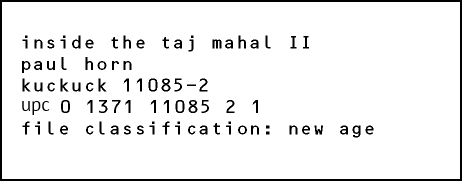 
the project
Twenty years after Paul Horn released his original Inside the Taj
Mahal recording in 1969, one of the most influential albums in establishing
the field of contemplative new age music, Horn returned to India determined
to commemorate the anniversary of this landmark album with a new digital
recording from the Taj Mahal. The first recording session happened almost
by accident. By asking a Taj Mahal guard if he could do a little informal
recording after hours, Horn created a masterwork of ambient flute improvisations
that changed the course of new age music almost overnight. However,
in 1989, political tensions in India made the same course impossible.
No longer able to slip into the palace unnoticed with flute and tape
recorder, Horn had to make a formal appeal to the Prime Minister for
permission. After finally gaining an audience with Rajiv Gandhi
and obtaining the blessing of the state, Horn still faced a host of
logistic difficulties, including equipment malfunctions and finding
ways to keep an increasing number of enthusiastic onlookers and roosting
birds quiet during the recording. The minute Horn's fluid improvisations
began resounding through the perfect acoustics of the Taj Mahal, it
was as if a charm had fallen over the palace. From that point on, everyone
knew that Inside the Taj Mahal II had been worth all the effort.
The resulting seventeen-piece The Taj Mahal Suite
reverberates with some of Horn's most beautiful work to date. Like
the original recording, each tone hangs suspended in space for a remarkable
twenty-eight seconds, allowing the artist to improvise to the
sound of his own echo. Unlike the original session where Horn played
only flute, for this project he was equipped with a soprano saxophone,
alto and bass flutes, and the Chinese bamboo flute (ti-tze),
adding a wealth of tonal color, emotive nuances, and flexibility to
his introspective reflections.
the artist
Trained in classical flute, Paul Horn has enjoyed a career that has
led him in many musical directions. He has played jazz with Chico
Hamilton, performed as a member of the NBC Hollywood Staff
Orchestra, coached Tony Curtis for his role as a musician
in Some Like It Hot and Wild And Wonderful,
appeared in several movies himself, and recorded with his own jazz quintet
in the 60s. Although he won two Grammy Awards at that time for his Jazz
Suite On The Mass Texts, his increasing dissatisfaction with
the Hollywood lifestyle led to studies in meditation with the Indian
master, Maharishi Mahesh Yogi. The experience profoundly
affected Horn's life as well as his music. Exploration of new ways to
play his instrument, stressing intuition and contemplation over intellectualism
and virtuosity, led to the acclaimed Inside series. Traveling around
the world, Horn embarked on a musical odyssey, producing recordings
in many great acoustic spaces besides the Taj Mahal, including the Great
Pyramid of Egypt and the cathedrals of Russia. Open to the richness
of music from many different cultures, Horn has recorded a wide range
of music, from China (11080) to the classical
Western recording, The Peace Album (11083).
While searching for new forms of expression, he continues to write highly
refined ensemble works and to tour the world from his home base in Victoria,
British Columbia.
|



